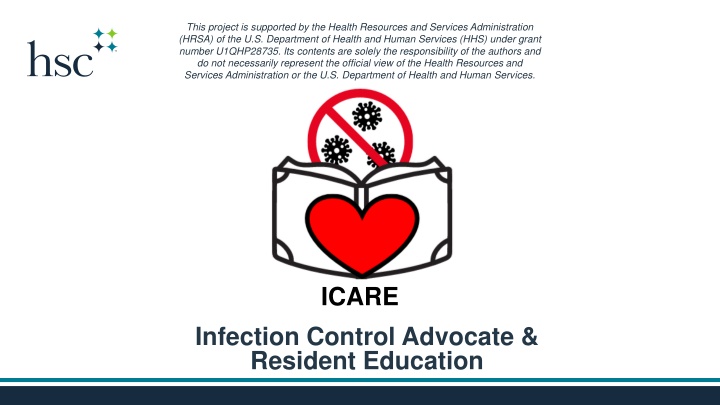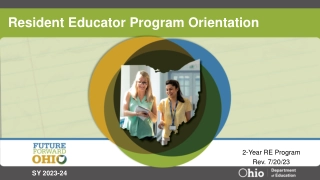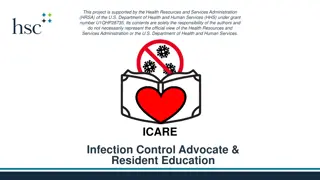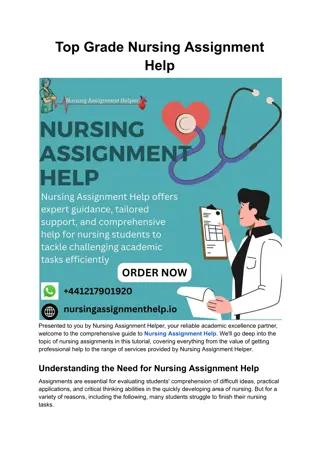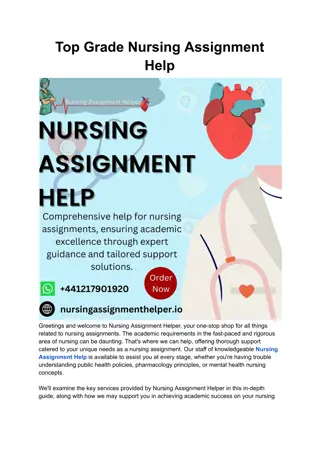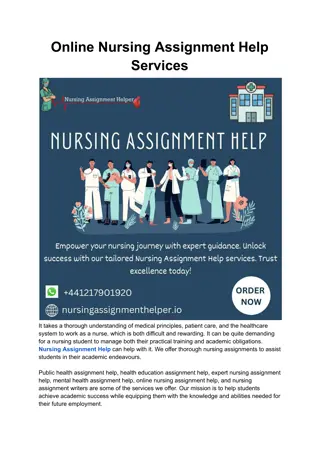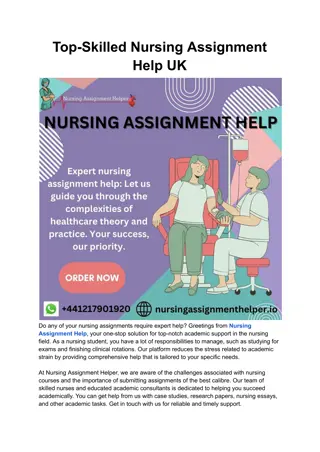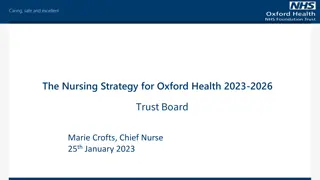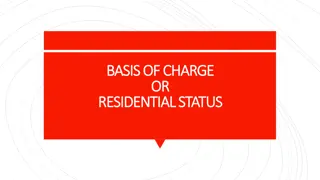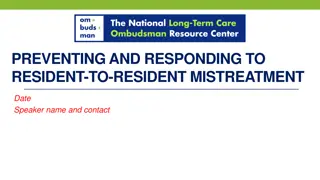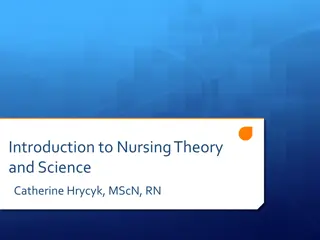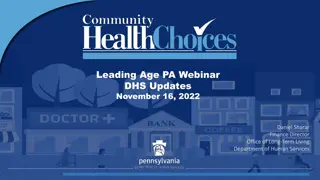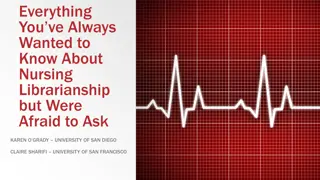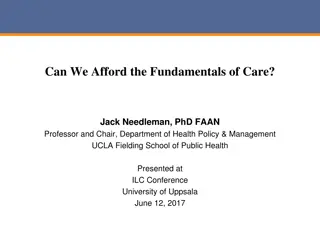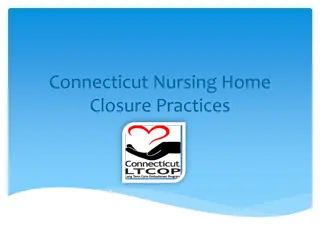Infection Control Advocate & Resident Education: Essential Elements for Nursing Home Emergency Response
This project, supported by HRSA, focuses on preparing nursing homes to respond effectively to emergencies, including infectious disease outbreaks. It covers topics such as mitigation, preparedness, response, and recovery, emphasizing resident rights and infection control measures. Key elements include risk assessment, planning, collaboration, and updating emergency preparedness programs.
Download Presentation

Please find below an Image/Link to download the presentation.
The content on the website is provided AS IS for your information and personal use only. It may not be sold, licensed, or shared on other websites without obtaining consent from the author.If you encounter any issues during the download, it is possible that the publisher has removed the file from their server.
You are allowed to download the files provided on this website for personal or commercial use, subject to the condition that they are used lawfully. All files are the property of their respective owners.
The content on the website is provided AS IS for your information and personal use only. It may not be sold, licensed, or shared on other websites without obtaining consent from the author.
E N D
Presentation Transcript
This project is supported by the Health Resources and Services Administration (HRSA) of the U.S. Department of Health and Human Services (HHS) under grant number U1QHP28735. Its contents are solely the responsibility of the authors and do not necessarily represent the official view of the Health Resources and Services Administration or the U.S. Department of Health and Human Services. ICARE Infection Control Advocate & Resident Education
Infection Control Advocate and Resident Education Nursing Home Response- Outbreaks and Other Emergencies
A cold, windy day at the Springville Nursing Home...
Mr. Johnson: Involved but Interrupted Collaborating with pharmacist & infection preventionist Resident and family committee Infection prevention for those with dementia Winter weather preparedness
Ms. Johnson worries and wonders What is needed to prepare and respond to emergencies? What are outbreaks and how can they be stopped?
What Will I Learn? What are the elements a nursing home must consider to prepare and respond to emergencies? What constitutes an infectious disease outbreak and how can they be prevented and controlled? How can planning and participation respects resident rights while preventing and controlling infections?
Emergency Management Phases Mitigation Preparedness Mitigation Preparedness Response Recovery Emergencies can be prevented or minimized with proper planning! Recovery Response
Emergency Preparedness: Core Elements Risk Assessment and Planning Mitigation Preparedness Response Recovery Requirement Facility specific AND community specific using an all hazards approach; guide plan. Major Points Resident profile and needs Capabilities & capacity Focus on high volume/risk Strategies to address risks Cooperation & collaboration Review & update minimum annually Risk Assessment and Planning Emergency Preparedness Program
Emergency Preparedness: Core Elements Policies and Procedures Requirement Based on risk assessment, emergency & communication plan Major Points Evacuation Track sheltered staff & residents Shelter in place Medical documentation Volunteer/surge need Other facility arrangements Review & update minimum annually Risk Assessment and Planning Policies and Procedures Emergency Preparedness Program
Emergency Preparedness: Core Elements Communication Plan Requirement Communication to ensure coordination of care Major Points Internal and external to facility Contact information Continuity of care Abilities & needs Residents & families- emergency plan Review & update minimum annually Risk Assessment and Planning Policies and Procedures Emergency Preparedness Program Communication Plan
Emergency Preparedness: Core Elements Training and Testing Requirement Training (awareness & education) & testing (operationalize training) Major Points Education and training of staff, volunteers, other who provide services Knowledge demonstration Drills & exercises Documentation Annually (drills/exercises 2X) Risk Assessment and Planning Policies and Procedures Emergency Preparedness Program Communication Plan Training and Testing Emergency and standby power!
Emerging Infectious Diseases (EIDs) Emerging Infectious Diseases Nursing home residents at high risk for severe outcomes Localized or widespread- coordinate with state and local officials Reoccurring Considerations Equipment & supplies Screening & testing Transfers & discharges Physical environment & surge capacity
EID: Prevention and Control Outbreak More confirmed or suspected cases of disease- time and place or group Rare or serious diseases- one case! Outbreak Response Effective and timely response Prevention and control Prevention precautions See other ICARE lessons!! Direct and indirect transmission Public health- resources & requirement
Water Plan & Outbreaks Legionnaire's Disease Residents-pneumonia Thrive in water systems Droplets, aerosols, aspiration Water Water Systems Water Management Plan Assessment Minimize risk Maintenance & control Legionella
Quality Care & Resident Rights Emergency management programs and plans Emerging infectious diseases and outbreak Water management plan Infection Prevention & Control Resident Rights Quality Infection Prevention & Control Resident Rights Participation and Planning
Resident & Advocate: Rights & Responsibilities Planning Emergency preparedness plan Plan with residents and family members Participation Risk assessment Infection prevention and control
Nursing Home Requirements: Infection Prevention & Control Emergency preparedness to assess, plan, and collaborate so residents receive competent care Strong Infection Prevention and Control Program Infection prevention and control plan with risk assessment, outbreak management, and prevention and control measures Federal and State Law Requirements Strong Emergency Preparedness Program Water management plan that assesses, minimizes, includes maintenance, and controls
Ms. Johnson Prepares Planning Resident care focus Plan flyers Participation Risk assessment Testing exercise
Discussion Are you aware of the specific emergency response plan at this facility? Do you think emergency preparedness programs work well to protect residents? Why or why not? How do you think COVID-19 changed the facility s outbreak response plan? Is there room for improvement and if so, how can you take part in this? Have you heard of a water management plan before this lesson? Do you have any concerns about the facility s water system?
Advocacy: Next Steps Education Nursing home specific risk assessment Water management plan Engagement Resident or family council to review training and testing Empowerment Risk Assessment Resident and/or family member role in exercise
This project is supported by the Health Resources and Services Administration (HRSA) of the U.S. Department of Health and Human Services (HHS) under grant number U1QHP28735. Its contents are solely the responsibility of the authors and do not necessarily represent the official view of the Health Resources and Services Administration or the U.S. Department of Health and Human Services. https://www.unthsc.edu/ICARE ICARE Infection Control Advocate & Resident Education
